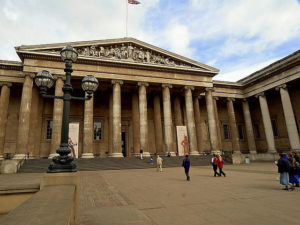Many have hailed non-fungible tokens (NFTs) as the future of art and art collecting. But there are just as many who astutely highlight some of the drawbacks. I’ve previously written about how the technology behind NFTs can make it easier for scammers to sell digitized artworks without the original creator’s permission. There’s also the budding NFT collector culture that rewards a lack of creativity, with monkeys, lions, or other animals generated and customized by computer code rather than anything resembling a creative process. But not many people are talking about the real-world impact of NFTs, namely the environmental cost. And more people were made aware of that when it was reported that the British Museum used up nearly sixty years’ worth of power just on their NFT project.
Because the British Museum is a public institution, it doesn’t take a Bob Woodward-level of investigation to find out about this. Partnering with the digital arts organization LaCollection, the British Museum has minted over two thousand NFTs to date. They are mainly digitized versions of their collection highlights, like the paintings of J.M.W. Turner. But while some critics will liken an NFT to a very expensive JPEG image, one of the main differences is that NFTs take so much more computer power to mint and exchange. Experts in cryptocurrency and NFTs estimate that, on average, a single transaction, a single change to the blockchain, uses up enough electricity to emit around 330 lbs. of carbon dioxide. This is around the same amount the average American home uses over nine days. Adding everything up, the British Museum and their partners have used up enough electricity to put out 348 tons of carbon dioxide into the atmosphere, enough to power that same home for fifty-seven years. But some estimates say the emissions are much higher, around 900 tons. While LaCollection has promised to plant one tree for every NFT it mints, that won’t exactly provide much of a counterbalance. The average tree does absorb about one ton of carbon dioxide over one hundred years. Not exactly the pressing sort of solution we all need right now, I would think. Similarly, NFT artists like Mike Winkelmann, also known as Beeple, promised to invest in renewable energy and conservation projects. Environmentally-conscious artists not involved with NFTs, like Ashley Grace, are very pessimistic about these attempts at balance, calling them an “ecological nightmare pyramid scheme”.
The British Museum does have a sustainability policy, but it is still a relic from 2007. It promises “the elimination or reduction of any detrimental impact that [the museum’s] activities might have on the environment.” With the current pandemic placing a financial strain on many major art institutions, places like the British Museum will auspiciously forget or possibly just flat-out ignore their previous promises. While the need for funds is understandable, this has not stopped other British art institutions from cutting off ties with environmentally-harmful practices and organizations, like the National Portrait Gallery’s severing ties with British Petroleum in February. On the other hand, the British Museum has gone whole-hog into the NFT world, and they have continually balked at cutting ties with BP. Thankfully, some in the cryptoverse advocate moving cryptocurrency-mining and NTF-minting computers onto grids powered by renewable sources. There’s also some support for changing NFTs from being backed by Ethereum cryptocurrency to something that consumes less energy and is a little more sustainable. While these ideas have been floating around for a bit, they’re still just ideas. And it can sometimes be excruciating to remind some people that while NFTs and bitcoin are intangible things, the Earth is very much real.

